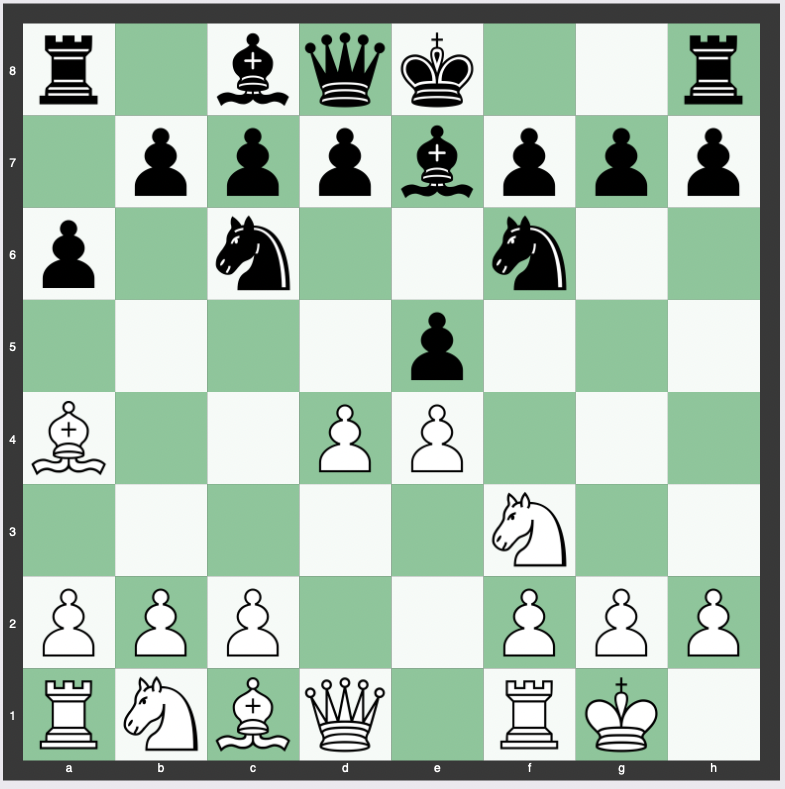A fascinating aspect of the Ruy Lopez is the Center Attack, which is introduced after 1. e4 e5 2. Nf3 Nc6 3. Bb5 a6 4. Ba4 Nf6 5. O-O Be7 6. d4.
Here we look into the different facets of this intriguing chess line, diving into its move order, theory, variations, history, and its applicability for different levels of players, including grandmasters.
Move Order of the Center Attack
The move order for the Center Attack in the Ruy Lopez is a precise sequence that begins with 1. e4 e5 2. Nf3 Nc6 3. Bb5 a6 4. Ba4 Nf6 5. O-O Be7 6. d4.

Here, White aims to gain control of the center, while Black responds by developing pieces and putting pressure on White’s e4 pawn.
Theory, Strategy, and Purpose of the Center Attack
The theory behind the Center Attack is based on White’s ambition to control the center of the board.
By moving the pawn to d4, White challenges Black’s central e5 pawn, pressuring Black to make a decision.
The purpose of this move sequence is to create opportunities for White, both in terms of opening up lines for pieces and potentially gaining a spatial advantage.
Variations of the Center Attack
Variations can arise based on Black’s response to 6. d4.
One popular response is 6… exd4, leading to complex play if 7. Re1.
Another line is 6… d6, solidifying the center and leading to a more closed, strategic battle. However, this is less accurate.
These variations offer diverse playing styles and numerous possibilities for both players.
6… exd4 gives black a slight advantage with an evaluation of approximately -0.10 to -0.20.
Continuation Lines in the Center Attack
Sample continuation lines in the center attack include:
6… exd4 7. e5 Ne4 8. Nxd4 O-O 9. Nf5 d5 10. Nxe7+ Nxe7 11. c3 Nc5 12. Bc2 Bf5 13. Na3 Qd7 14. Bg5 Bxc2 15. Nxc2 Ng6 16. Nb4 c6 17. Be3 b6 18. f4 f6 19. exf6 Rxf6 20. g3
6… exd4 7. e5 Ne4 8. Nxd4 O-O 9. Nf5 d5 10. Nxe7+ Nxe7 11. c3 Nc5 12. Bc2 Bf5 13. Na3 Qd7 14. Bg5 Bxc2 15. Nxc2 Rae8 16. Bxe7 Qxe7 17. Qd4 c6 18. Rae1 Ne6 19. Qd2 f6 20. Nd4 Nxd4 21. cxd4 fxe5 22. Rxe5 Qd7
6… exd4 7. e5 Ne4 8. Nxd4 O-O 9. Nf5 d5 10. Nxe7+ Nxe7 11. c3 Ng6 12. f3 Nc5 13. Bc2 Nxe5 14. b4 Ne6 15. f4 Nc4 16. f5 Ng5 17. f6 Ne4 18. fxg7 Re8 19. Qh5 Ne5 20. h3 Ng6 21. Qf3 f5 22. Nd2 Be6 23. Nb3 Nh4 24. Qf4 Nxc3 25. Nd4 Qf6 26. Be3
6… exd4 7. e5 Ne4 8. Nxd4 O-O 9. Nf5 d5 10. Nxe7+ Nxe7 11. c3 Nc5 12. Bc2 Bf5 13. Na3 Qd7 14. Bg5 Rae8 15. Bxe7 Rxe7 16. Qd4 Ne6 17. Bxf5 Nxd4 18. Bxd7 Ne2+ 19. Kh1 Rxd7 20. Rad1 Re8 21. f4 d4 22. g3 f6 23. Rd2 d3 24. exf6 b5 25. fxg7 c5 26. f5
History of the Center Attack
The Ruy Lopez has been played for over 500 years, and the Center Attack is an essential part of its rich history.
This particular line has been employed by many World Chess Champions and has contributed to the development of modern chess strategy.
Is the Center Attack Good for Beginners or Intermediates?
The Center Attack in the Ruy Lopez is suitable for both beginners and intermediate players.
For beginners, it offers a logical sequence of moves that emphasizes classic opening principles.
For intermediates, it provides a platform for understanding deeper strategic nuances and complex middlegame plans.
How Often Is the Center Attack Played at the Grandmaster Level?
At the grandmaster level, the Center Attack is less common compared to other lines in the Ruy Lopez.
While it is not as prevalent as other variations, it has been played in high-level games and continues to be a valid and intriguing choice.
Conclusion
The Center Attack in the Ruy Lopez is a captivating chess opening that encapsulates the rich complexity of chess strategy.
From its precise move order to its theoretical depth, variations, and historical significance, this line offers something for players of all levels.
Whether you are a beginner looking to learn foundational principles or an intermediate player aiming to deepen your understanding, the Center Attack provides a challenging and rewarding pathway to explore.
Its continued relevance in grandmaster play underscores its enduring appeal and the timeless nature of chess itself.


